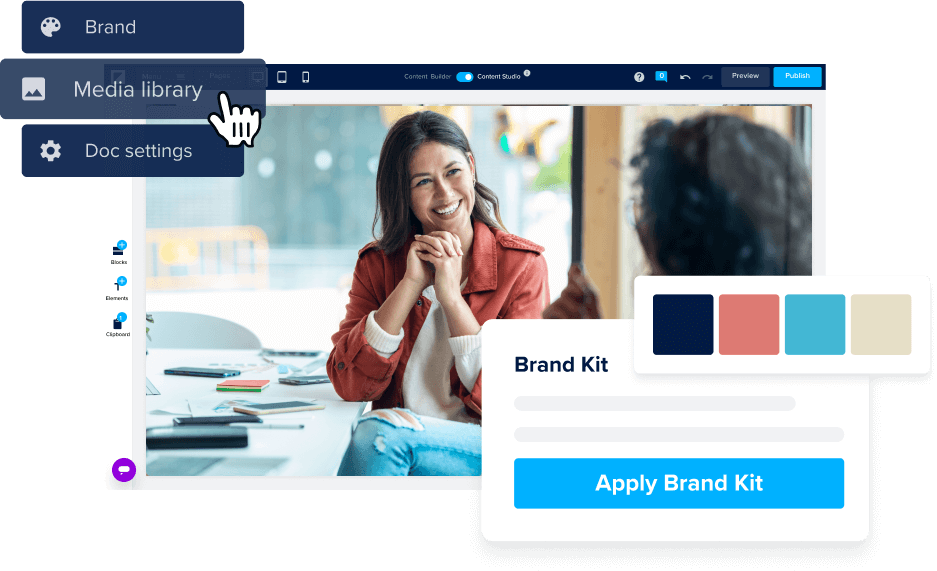Every content creator’s inspiration levels dwindle from time to time. Sometimes you just can’t find the right hook for your email campaign. On other days your team might come up against a brick wall while brainstorming new ideas for blog articles.
All writers know there is nothing worse than looking at a blank page. Those wasted, frustrating minutes and hours are far better spent working through those creative blockages and rediscovering your content inspiration!
This article will offer some proven methods to keep your content creators motivated and inspired — no matter how long they've been writing about a subject or on behalf of your brand. We’ll look at how your analytics can help fuel your creativity and how simply upping your format game can reveal all sorts of opportunities.
Intrigued? Let’s get started!
Conduct brainstorming sessions
Brainstorming sessions are an old favorite for marketers who want to revitalize their campaigns, zhuzh up their messaging, put a fresh spin on a service or devise a product launch strategy. However, like many tried and tested formulas, people can approach these sessions with a bit of a been-there-done-that attitude. The best way around this? Breathe new life into brainstorming!
Too often, these important marketing clinics are organized too sporadically, so there’s little opportunity to build momentum and cohesion and give everyone a chance to express their point of view.
Ideas can get lost over time, too. You might forget to mention that must-have content creation platform you read about a fortnight ago. Or a colleague’s lightbulb moment last month about enhancing the company’s tone of voice will be forgotten if you don’t keep the brainstorming flow going.
Here are some tips for organizing and delivering brainstorming sessions that will keep your content creators inspired.
- Make brainstorming sessions a regular fixture. Once a month might be too often, but quarterly could be too infrequent. Talk to your team, see what works best for them, and balance it with other regular meetings. You don’t want to overwhelm your team after all.
- Make it fun! Include activities where you decide on a celebrity who could represent your brand if you had the towering budget required. Then take turns to literally speak about your products in their voice and with the gestures they are renowned for. Or you could try quick-fire word associations based on your services or the desired responses from customers. Whatever it takes to shift those inspiration blockages.
- Bring specific questions for the team to answer. This is a great method for getting past gazing at that blank page. Ask both your content creators and any other relevant colleagues to bring questions relating to business challenges that you might be able to solve with content. This can open up all sorts of opportunities for your creative people and your wider workforce to collaborate.
You can learn more about each other's experiences in the sales and customer journey. You can exchange ideas and think about how you can work together to enhance different parts of the creative process. I'm willing to bet that the insights you get from those who have more direct contact with your customer base will reveal some fabulous ideas for your content calendar, as well as ways you can improve your tone of voice and messaging.
Deep-dive into your analytics and results
When you’re trying to get as much quality content to market as humanly possible, it’s easy to forget to take time to check your analytics and learn from how your audience is finding and consuming your content.
In addition to providing important insights into ways you can optimize your campaigns and improve audience engagement, giving your team an understanding of how the content they create is being consumed will fuel their creativity.
Seeing how a particular blog sparked a raft of comments from a specific demographic could inspire the writer to develop that into an interactive guide (more on this later).
Or, if you notice that a timely, relevant long-form article wasn’t read past the third paragraph by the majority of your audience, you could adapt that topic into a format that is easier to digest, such as a quick how-to video or a shorter need-to-know update.
It’s about optimizing the great content you’ve created and repurposing it, so it has another chance to shine. It’s also an excellent learning tool and a chance to recognize your colleagues' success when their content performs well.
Conducting an audit of your keywords and search terms is also a great source of content inspiration. Take some of your high-performing keywords and run them through a tool like Answer The Public.
You’ll get plenty of ideas for common queries your audience might have around a topic and then build a how-to or blog to help them find their answer (and demonstrate your expertise). You can also check BuzzSumo, social listening tools, or the related searches at the bottom of Google’s SERPs for more ideas.
Besides finding new ways to optimize existing content, reviewing your analytics gives your content creators valuable insights into what your audience loves (or doesn’t), so they can do more or less of the right things.
It’s important to get these insights on as much of your content as possible. At Foleon, we talk to a lot of businesses who don’t get these insights on most of the content living outside of their websites, such as white papers, ebooks, reports, factsheets, and brochures.
These content assets provide some of the most important links in the buyer journey. If you can’t understand how your leads or customers interact with them, you can’t improve your buyer journey and don't have the whole picture of what your reader needs.
If you want to stop missing out on important customer insights, request a demo for Foleon’s content platform today or find out more in our guide to the 4 reasons you need a content creation platform.
Get your content creators talking to your audience
As with carving out time to review your audience analytics, it is easy to let months fly by without actually speaking to customers. A ten-minute interview asking about their experience of using your products or service, any issues they had, what they liked most, why they chose you over competitors, and what inspired them to seek out a solution in the first place can uncover content marketing gold. You might even be able to use direct quotes from the customer in an article or on your website or record them for a video case study.
Alongside direct customer conversations, listen in on sales calls with prospects to get an idea of the common barriers to sale and the messaging that works and doesn’t. Your team can use these insights to inform their marketing collateral.
Customer review sites are another valuable portal into your customer’s perceptions of your brand and a great way of finding out what makes them tick. You might discover a problem with uptake that could be remedied with a video explainer. Or you may find they love a particular feature that you thought was more of a nice-to-have which you could then amplify in your content.
Let them experiment with content formats
Gone are the days when copywriters and content marketers were limited to static formats. Not all of us have design capabilities, but with the handy tools and platforms available today, creating an interactive content experience is as simple as drag and drop.
Encourage your team to try out new content formats that could provide a more entertaining experience for your leads and customers and boost engagement. Producing a podcast to present the latest findings of a report may work wonders, or adapting a product catalog into a slideshow might give it a new lease of life.
Including interactive elements is a highly effective and proven method of increasing engagement with your audience. Rather than your reader passively consuming the content, prompting them to interact puts them in the driving seat. The result? More memorable content that continues to resonate with your customers and keeps your brand at the forefront of their minds. Curious about how it works? Check out these examples.
Don’t forget to keep an eye on your analytics when you and your team are trying out new content formats. Check there aren’t any barriers to usage and that people can find the information they need. (Psst Foleon’s platform has powerful analytics baked in, making this part of the process super easy).
Keep an eye on your content creator's progress
It’s important to make sure that your efforts to keep your content creators inspired are working. Perhaps you could take time during the brainstorming sessions to discuss what’s currently motivating them or otherwise. Or have a short session during meetings where a team member talks about a great new tool they discovered or a marketing or advertising campaign that they enjoyed.
It doesn’t even have to relate to your internal marketing activities or your brand. Inspiration comes from all manner of sources, and the most important thing is that your team can access it and apply it to their work in whatever way they see fit.
Keep in mind that your colleagues will struggle to connect with their creativity if they are weighed down by unnecessary admin or menial tasks. Of course, there’s the paperwork we all have to do, but it’s a good idea to review your processes periodically to see where you can streamline admin work to give them more time and headspace to be creative.
You can also invest in technologies that boost the creative process, such as these we cover in our very own Sean’s recent article on Tools that actually help you scale content creation.
Taking the next steps to content inspiration
I hope you now have plenty of ideas for how you can motivate and encourage your team to think outside that ol’ restrictive box when creating content.
While you need to make sure your content is on brand and that it represents your people and your company in the appropriate light, there is no harm at all in stretching those creative muscles. There’s an awful lot of noise to cut through in today’s content-saturated world. Your team needs the tools, insights, and assets to stand out above the rest. That just can’t happen without plenty of inspiration.



